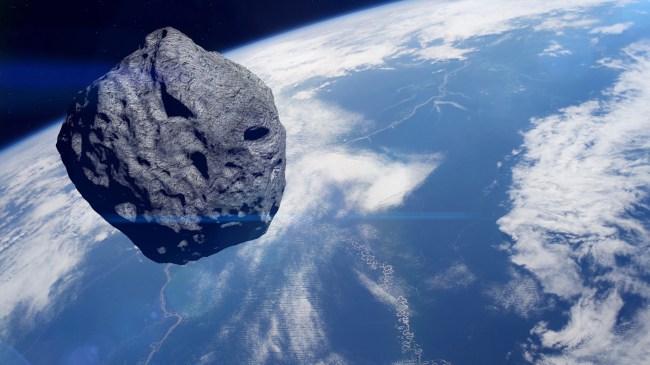iStockphoto
There’s a slim chance a sizeable asteroid could collide with our planet in 2032, and it’s fair to wonder why the powers that be wouldn’t use the tools at their disposal to minimize the risk of a potential impact. However, an expert has shed some light on why attempting to deflect it could do more harm than good.
It’s been 65 million years since the majority of the species on the planet were wiped out by the sizeable asteroid that brought the reign of dinosaurs to an end, which is one of the approximately 60 times the Earth has taken a blow from an extraterrestrial rock measuring at least three miles in diameter (that one clocked in at between six and nine).
We’ve thankfully been spared any similarly cataclysmic incidents since Homo sapiens started doing their thing around 300,000 years ago, and humans have reached a point where it’s not only possible to track the asteroids that potentially pose a threat but theoretically alter their trajectory to make sure they don’t hit Earth.
In 2022, NASA proved that second feat is possible with the Double Asteroid Redirection Test (DART) mission that successfully changed the direction of Dimorphos, an approximately 175-meter-wide asteroid orbiting a larger one that was knocked off of its original path after a spacecraft was purposefully crashed into it.
That object is at least twice the size of 2024 YR4, a “near-Earth” asteroid around the length of a football field NASA recently said has an approximately 2.2% chance of crashing down to the surface of our planet on December 22, 2032. Given the success of the DART mission, it’s fair to wonder why that potential threat isn’t currently a candidate for a similar treatment, but there are a a couple of reasons it may not be the best idea.
On Tuesday, Dr. Robin George Andrews, a volcanologist who also knows a thing or two about the topic I’ve been discussing as the author of the book How To Kill An Asteroid, shed some light on why it’s probably a good idea to leave 2024 YR4 alone for the time being in a thread of tweets outlining the potential downsides.
Hey asteroid 2024 YR4 watchers! I’m seeing a lot of people claim that, if it is going to impact Earth in 2032, we can use a DART-like spacecraft to ram it out of the way.
Well, not necessarily. The DART mission was fab, but might not be able to stop 2024 YR4.
Let me explain 👇 pic.twitter.com/JzBfEx2TxG
— Dr Robin George Andrews 🌋☄️ (@SquigglyVolcano) February 11, 2025
Andrews notes the DART mission had a fairly minimal impact on the overall trajectory of the asteroid that was targeted while asserting any agency tasked with running a similar mission would need to execute it at least 10 years before the predicted impact (if you somehow can’t do the math, we have less than eight years to prepare for 2024 YR4).
He also points out that asteroids that size tend to consist of multiple large rocks held together by gravity that have the potential to become dislodged and scatter if the impact the spacecraft being used to deflect it is too strong; he deployed the analogy “turning a cannonball into a shotgun spray” to highlight a possible scenario where the planet ends up being struck by multiple smaller ones that could still do plenty of damage on their own.
Andrews didn’t rule out a potential deflection attempt if the odds of a direct impact from 2024 YR4 rise as we near 2032 and floated the potential of a “monster-sized spacecraft” or the Armageddon-inspired use of a nuclear weapon to achieve it.
I guess we’ll just have to wait and see how things pan out.

